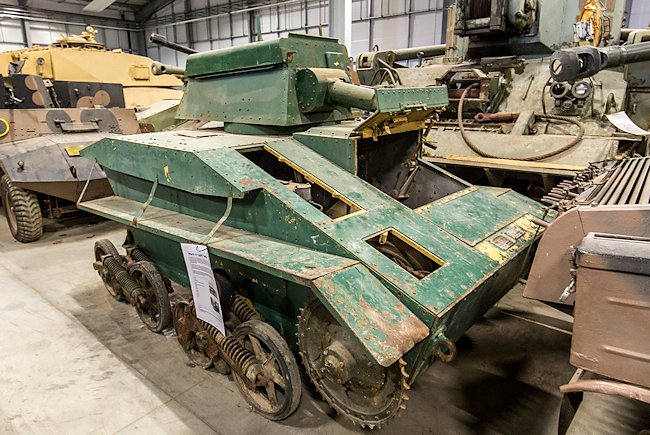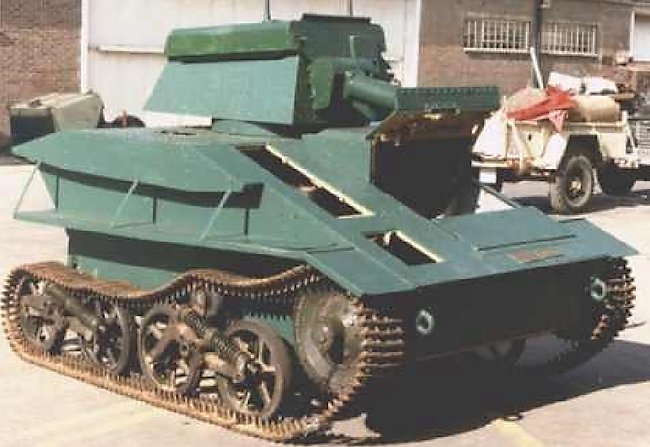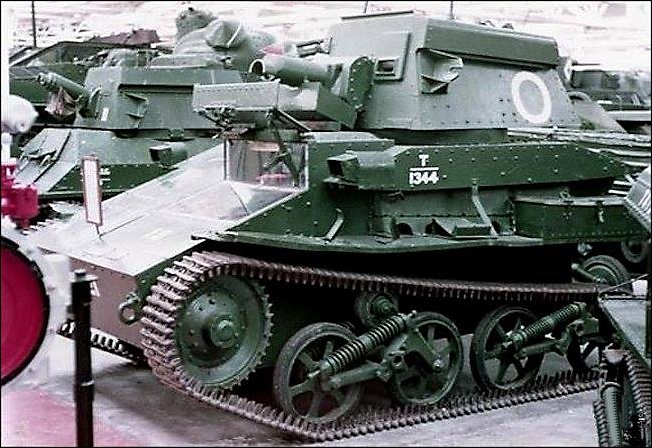The Vickers Mk IV Light Tank
This British Vickers MkIV Light Tank at the Tank Museum, Bovington, England. The Vickers MkIV Light Tank had a two man crew and was meant for Colonial policing deployment not the front line of a modern battle. It was officially designated A4E19, Light Tank Mk II Indian Pattern No.1 and L2E1.

The Vickers MkIV Light Tank at the Tank Museum, Bovington, England. Officially called the A4E19, Light Tank Mk II Indian Pattern No.1 and L2E1
Location
This Vicker's Armstrong Light Tank MkIV was on show at the Tank Museum, Linsay Road, Bovington, Dorset. It is currently being restored in Kent.
The last bus back to the station from the Tank Museum is just after 13.45 which is really silly. There is no Sunday bus service. The easiest way to get to the museum from the train station is by taxi. They can be pre booked with Garrison Cars to meet you when your train arrives and pick you up for the return trip from outside the museum. Their phone number is 01929 463395
Specifications
The Vickers MkIV light tanks was powered by a Rolls-Royce 6 cylinder petrol engine that produced 66 hp. The tank had a maximum road speed of 30 mph (48 km/h) and a off road speed of 21 mph (30 km/h). It had a range of around 173 miles (279 km) before it needed to refuel. It was armed with a .303 inch (7.7mm) Vickers water cooled machine gun. The two man crew were protected by armour that ranged in thickness form 4 to 12 mm. It weighed 4.5 tons.

An older photograph taken when the Vickers MkIV Light Tank still had it's tracks on and a nice coat of paint
The tank's history
This Vickers Mk IV Light Tank was loaned to the British Army by Bovington Tank Museum following a request that their apprentesis be allowed to continue the restoration process and learn new engineering skills. This seemed like a good idea at the time. When the Museum visited to check how they were doing they found that work had stopped and the hull was partly stripped. With a new set of managment, training priorities had changed and no further work was done on the tank. The Museum then collected the bits and it lived in the tank museum Nevs Shed for decades. It was later moved to the new vehicle conservation hanger for storage. In 2016 it was decided to send the vehicle away to be fully restored.
Design and production
The early Carden-Loyd tankettes were invented by Major Giffard LeQuesne Martel in 1929 for the British Royal Army Corp. With the success of his prototype, and after many modifications, the production for export shifted to Vickers-Armstrong. Besides the numerous customers for this cheap and fast light vehicle, many armed derivatives were built.
The development of the turretless versions, which was carried out by the Experimental Mechanized Force unit, became the popular Universal Carrier series, of which over 100,000 were produced. On the other hand, the Royal Tank Corps requested a turret-armed version, in order to test its tactical potential. This led to the development of the Vickers Mk.I Light Tank.
During the dark economical times of the 1930s depression small light tanks were cheaper and easier to maintain, with better standardization, and requiring only two men each. Vickers had the start of a good export business. These small tanks were intended for police duties in the colonies, not front-line action.
The Vickers-Armstrong Mk.IV was a new model in the series of Vickers light tanks. This already comprised of more or less experimental and short series vehicles, the Mk. I to III. For the next one Vickers planned a brand new hull design, roomier, a simpler wheeltrain, as well as a sturdier chassis.
It had been planned, at first, for colonial duty in India, and, at the same time, as a “universal model”, which could be mass-produced for export. But it would only be a stopgap model before the first British light three-man tank, the Mk.V, ultimately leading to the real-mass-produced Vickers Light Tank of the war, the Mk.VI.

In this old photograph you can see the Vickers MkIV Light Tank parked by the side of the Vickers MkIIa in the background at Bovington Tank Museum.
The Vickers MkIV Light tank was officially designated A4E19, Light Tank Mk II Indian Pattern No.1 and L2E1.
he design resulting from the Vickers’ studies reminds of the Mk.II, but the chassis was left with two Hortsmann spring suspension (in “quad scissors”) front drive sprockets and no idlers. However, it was decided to abandon the guide wheels and supporting rollers. Such a move gave several advantages. It reduced the length of the tank, increased seat track mover and facilitated construction of the chassis as a whole.
The only serious shortcoming observed later was somewhat poorer mobility, compared with earlier versions. Much of the suspension housing was redesigned to fit the future export Vickers Light M1933. The nose bow used a solid armor plate set at a large angle of inclination, instead of two joined plates. On the right was placed a 6-cylinder gasoline petrol Meadows ETS (giving 88 hp), and the transmission unit behind. On the left was located the driver’s seat, with a small armored superstructure.
The fighting compartment occupied the middle of the hull. The turret was placed above it, offset to the right. It was of hexagonal shape, relatively small, housing a single cal.303 (7.7 mm) liquid-cooled Vickers standard machine gun. Compared with the Mk. III, the hull was 6.1 in (15.4 cm) shorter and 7.8 in (20 cm) wider.
However it appeared that battlefield awareness in combat situation was severely limited. The driver saw the terrain through a thin bulletproof glass observation slit, awkwardly located in the hatch. The tank commander could use only the optical machine-gun sight, set in the turret. On the march he used to stand out of the open hatch, leaning out of it on the belt. Trials began in 1931, the prototype performing well.
At a fighting weight of 3400 kg, it developed a maximum road speed 58 km/h (36 mph) and had comparable crossing abilities to the Mk.III. At the same time, the military commission noted a number of shortcomings that prevented its adoption into service, even for colonial duty.
The next prototype A4E20, numbered MT7984 (or Light Tank Mk II Indian Pattern No.1/L2E2), had a slightly modified body. The sights were improved, with new slits at right angles, and the design of the exhaust pipe and side niches was changed. The most important innovation was the standardized four-sided tower of increased size, protected by 9 mm (0.35 in) of armor. Elevation for the machine gun was raised to -10 to +37 degrees. A water tank was mounted just under the roof, to cool down the machine gun. This new experimental model was demonstrated once more to the RTC, which in 1933 decided to conclude a contract to produce a small batch under the ordnance designation Light Tank Mk.IV.
Later, after field experiences, serial machines were fitted with a return roller on both sides and a modernized turret traverse system, although still carried out using a flywheel with reduction – five turns made for a complete revolution. Maximum protection was now 12 mm (0.47 in) on the chassis nose glacis. The engine was upgraded to the Meadows ESTE, giving 88 hp.
Production lasted from 1934 to 1935, but was discontinued and eventually stopped because of several issues. The attempt to simplify the design had reduced its driving performance. A higher hull and heavier turret meant the gravity center was higher up, making the tank much more unstable. In addition, the Vickers machine gun was already clearly inadequate. Unfortunately, at that time, the Besa 13 mm (0.51 in) was not ready yet, and would have probably increased the stability problem. Only 34 rolled off the line.
Operational service
The Vickers Light Tank Mk.IVs were used for training purposes in the UK. However, it is believed that some of these were sent for advanced field training exercises in France in 1940, by the British Expeditionary Force BEF. By summer that year several were reported captured by German troops. In German Wehrmacht service, they were designated Leichter Panzerkampfwagen Mk.IV 734(e).
heir fate is unknown, but they probably served for training as well. None seem to have been sent in Libya or India. The colonial version was dropped in the meantime. Only one has survived to this day, now on static display at the Bovington Tank Museum.
Where can I find other preserved Vickers Mk IV Light Tanks?
- Tank Museum, Bovington, England
- Source - Pierre-Oliver Buan - http://the.shadock.free.fr/Surviving_Panzers.html
World War Two Books



